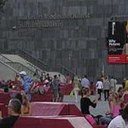0024 A Museum Open to the Street
Identifiers (Article)
Identifiers (Files)
Abstract
Glazed exhibition rooms, enabling passers-by to see works of art from the level and perspective of the street, without going inside. Merchandise displayed in an art bookshop, also visible from the outside, tempting passers-by. Café tables spilling out into the space of the adjacent town square. Sculptures, installations, but also benches and fountains placed in the public space, creating an entrance space. These are the characteristic components of democratic art institutions. Museums, galleries and centres of art – of contemporary art in particular – go out into the space of the street to encourage passers-by to step inside. This mutual permeation and observation of the two worlds – the outdoor world of the street and the interior holding cultural treasures – has become part of the cognition process in the museum and of artistic sensations.
Statistics


License

This work is licensed under a Creative Commons Attribution-NonCommercial-NoDerivatives 4.0 International License.



